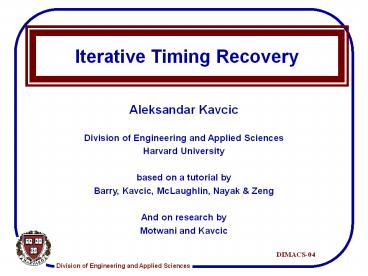Iterative Timing Recovery - PowerPoint PPT Presentation
Title:
Iterative Timing Recovery
Description:
Joint timing and intersymbol interference trellis. Soft decision algorithm. Performance results ... Trellis length = n (block length). ( note that each branch ... – PowerPoint PPT presentation
Number of Views:100
Avg rating:3.0/5.0
Title: Iterative Timing Recovery
1
Iterative Timing Recovery
- Aleksandar Kavcic
- Division of Engineering and Applied Sciences
- Harvard University
- based on a tutorial by
- Barry, Kavcic, McLaughlin, Nayak Zeng
- And on research by
- Motwani and Kavcic
2
Outline
- Motivation
- Timing model
- Conventional timing recovery
- Simple iterative timing recovery
- Joint timing and intersymbol interference trellis
- Soft decision algorithm
- Performance results
- Conclusion
- Future challenge capacity of channels with
synchronization error
3
Motivation
- In most communications (decoding) scenarios, we
assume perfect timing recovery - This assumption breaks down, particularly at low
signal-to-noise ratios (SNRs) - But, turbo-like codes work exactly at these SNRs
- Need to take timing uncertainty into account
4
Perfect timing
5
System Under Timing Uncertainty
- difference between transmitter and receiver
clock - basic assumption clock mismatch always present
6
A More Realistic Case
Sample instants kT ? kT?k
7
Properties of the timing error
- Brownian Motion Process (slow varying).
- Discrete samples form a Markov chain.
8
Timing recovery strategies
turbo equalization (inner loop)
a)
c)
timing recovery
symbol detection
timing recovery
symbol detection
decoding
decoding
?
?
free running oscillator
free running oscillator
iterative timing recovery (outer loop)
turbo timing/equalization
b)
d)
turbo equalization
timing recovery
symbol detection
joint soft timing recovery and symbol detection
decoding
decoding
?
?
free running oscillator
free running oscillator
9
Traditional Phase Locked Loop
10
Simplest iterative timing reovery
11
Simulation results
12
Convergence speed
13
Strategy to solve the problem
- Set up math model for timing error (Markov).
- Build separate stationary trellis to characterize
the channel and source. - Form a full trellis.
- Derive an algorithm to perform the Maximum a
posteriori probability (MAP) estimation of the
timing offset and the input bits
14
Quantizing the Timing Offset
Uniformly quantize the interval ((k-1)T, kT to Q
levels.
15
Math Model for Timing Error
State Transition Diagram
State Transition Probability
16
States for Timing Error
Semi-open segment ((k-1)T, kT Q 1-sample
states 1i i1, 2, , Q 1 deletion states 0 1
2-sample state 2
17
Example timing error realization
18
0
T
2T
3T
4T
5T
6T
7T
8T
9T
10T
0th interval
1st interval
2nd interval
3rd interval
4th interval
5th interval
8th interval
6th interval
7th interval
10th interval
9th interval
15
0
0
2
15
14
14
15
11
11
12
t
0-?0
3T- ?3
2T- ?2
5T- ?5
4T- ?4
T- ?1
6T- ?6
7T- ?7
8T- ?8
9T- ?9
0
11
12
13
14
15
2
19
Single trellis section
0
0
11
11
12
12
13
13
14
14
15
15
2
2
20
Source Model
Second order Markov chain
21
Full Trellis
Total number of states at each time interval
Trellis length n (block length). (note that
each branch may have different number of outputs).
22
Joint Trellis Example
a) pulse example
1
h(t)
0
-2T
0
-T
T
2T
3T
3T/5
-2T/5
8T/5
23
Soft-Output Detector
24
Definition of Some Functions
Definition
25
Calculation of the Soft-outputs
26
Recursion of a(t,m,i)
27
Recursion of ß(t,m,i)
28
known timing
conventional 10 iterations
10-1
after 2 iterations
after 4 iterations
after 10 iterations
10-2
bit error rate
10-3
10-4
2
3
4
5
6
29
Cycle-slip correction results
true timing error timing error estimate after 1
iteration timing error estimate after 2
iterations timing error estimate after 3
iterations
T
0
timing error
-T
-2T
1000
2000
3000
4000
5000
30
Conclusion
- Conventional timing recovery fails at low SNR
because it ignores the error-correction code. - Iterative timing recovery exploits the power of
the code. - Performance close to perfect timing recovery
- Only marginal increase in complexity compared to
system that uses conventional turbo
equalization/decoding
31
known timing
conventional 10 iterations
10-1
after 2 iterations
after 4 iterations
after 10 iterations
10-2
bit error rate
10-3
loss due to timing error Can we compute this loss?
10-4
2
3
4
5
6
32
Open Problems
- Information Theory for channels with
synchronization error - Capacity
- Capacity achieving distribution
- Capacity achieving codes
33
Deletion channels
- Transmitted sequence x1, x2, x3, .
- Xk ? 0, 1
- Received sequence y1, y2, y3, .
- Sequence y is a subsequence of sequence x
- Symbol xk is deleted with probability ?
34
Deletion channels
- Some results
- Ulmann 1968, upper bounds on the capacities of
deletion channels - DiggaviGrossglauser 2002, analytic lower bounds
on capacities of deletion channels - Mitzenmacher 2004, tighter analytic lower bounds
35
(No Transcript)
36
Numerical capacity computation methods
37
Received symbols per transmitted symbol
Let K(m) denote the number of received symbols
per m transmitted symbols K(m) is
a random variable Asymptotically, we have A
received symbols per transmitted symbol For the
deletion channel,
38
Capacity per transmitted symbol
compute
upper bound
39
Markov sources
If X is a first-order Markov source (transition
matrix P), then Y is also a first-order Markov
source (transition matrix Q)
Prob/xt
Prob/yt
st-1
st
st-1
st
P00/0
Q00/0
0
0
0
0
P01/1
P10/0
Q01/1
Q10/0
1
1
1
1
P11/1
Q11/1
40
Trellis for Y X
Prob/y1
Prob/y2
s0
s1
s2
11
02
(1-?)/1
(1-?)/0
0
(1-?)?/0
(1-?)?/0
Run a reduced-state BCJR algorithm on tis
trellis to upper-bound H(YX)
02
03
(1-?)/0
(1-?)?2/1
(1-?)?2/0
03
14
(1-?)/1
(1-?)?3/1
(1-?)?/1
14
15
(1-?)/1
41
(No Transcript)
42
Future research
- Upper bounds for insertion/deletion channels?
- Channels with non-integer timing error?
- Codes?
- (long run-lengths are favored in deletion
channels)































